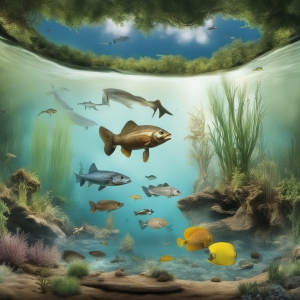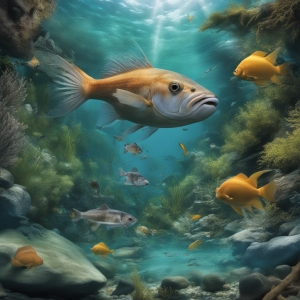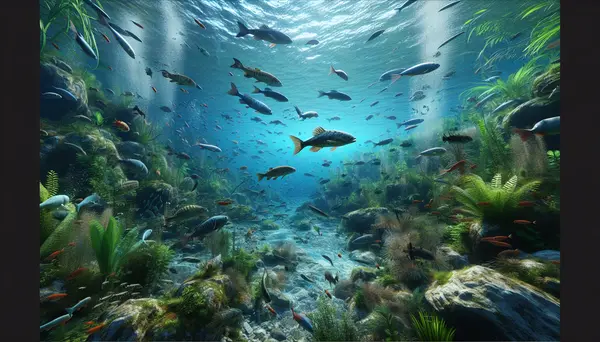Table of Contents:
Welcome, fellow adventurers, to another exciting exploration with Buzzerfish! Today, we dive into the mystical depths of the aquatic world. We're going to unveil the rich diversity of the freshwater habitats that our fishy friends call home. This is a fascinating journey that both novice and veteran anglers will find enlightening. Understanding these underwater habitats and their complex ecosystems can dramatically enhance your fishing experience and success rate.
Introduction: The Fascinating Freshwater Habitats
The world beneath the water's surface is truly intriguing. Unlike the terrestrial habitats that we are familiar with, freshwater habitats have their unique characteristics. They're extremely diverse and comprise of lakes, rivers, streams, and ponds. These habitats offer different conditions for fish - from crystal clear shallow streams to muddy ponds and deep, cold lakes. It’s in these rich underwater environments that our freshwater fishes thrive in.
Let's delve a little deeper to explore the fascinating world of freshwater fish and their habitats. Understanding their environment is the first step towards a rewarding fishing adventure. You will begin to appreciate the importance of factors like water quality, food availability, shelter and the influence of temperature on fish behavior. Armed with this knowledge, you’ll be better equipped to anticipate fish movements and choose your fishing spots wisely.
Understanding Freshwater Ecosystem and Fish Behavior
Let's start unraveling the mysteries of the underwater world. The first thing to remember is that freshwater ecosystems are fragile and complex. They are ecologically vibrant, supporting a vast array of fish species, plants, and other forms of aquatic life.
The quality of the water in these habitats is primarily determined by three key factors - dissolved oxygen, temperature, and pH levels. Any significant changes in these parameters can largely affect the aquatic life. Fishes, in their unique ways, respond to these environmental changes, which is a part of their innate survival mechanism.
Fish behavior is another fascinating aspect. Many fish species are known to migrate within their freshwater habitat based on environmental triggers like seasons and food availability. Puerto Rico's beautiful mountain mullet is one such example, which coordinates its movements according to the rainy season! Understanding these behaviors can significantly boost our fishing success.
Food availability is a direct determinant of fish concentration in a given area. For instance, areas with a lot of aquatic vegetation like reeds and weeds usually harbor an abundance of insects, a primary food source for many fish species, making it a hotspot for anglers.
The zigzag pattern in which fish swim, their feeding patterns, and even resting periods play an important role in fishing. Monitoring these behaviors can equip us with essential clues about the best times to fish and significantly improve our catch rates.
Freshwater Fish Habitats: Advantages and Disadvantages
| Aspect | Advantages | Disadvantages |
|---|---|---|
| Biodiversity | High diversity of species increasing the ecosystem stability. | Risk of invasive species can disrupt local ecosystems. |
| Ecosystem Services | Freshwater habitats often provide key ecosystem services such as water purification. | Disturbances can lead to loss of these ecosystem services. |
| Research Opportunities | Freshwater habitats provide numerous opportunities for scientific research and discovery. | The inaccessibility of certain areas can make research difficult. |
| Conservation | Freshwater habitats can be targeted for conservation efforts. | Ongoing threats from human activity, like pollution and overfishing. |
Exploring the Different Types of Freshwater Environments

Let's dive deep into the diverse dunk of freshwater environments. Understanding the variants in the underwater world greatly enhance our chances of landing a prize catch. Each type of water body possesses distinctive characteristics, providing specific living conditions for various fish species.
Rivers and streams: These moving water bodies are the lifeblood of many ecosystems. Fish species that dwell in these fast-flowing habitats need to adapt to overcome challenges like strong currents. Trout, for example, are well-suited for life in rivers thanks to their streamlined bodies.
Lakes and ponds: These stagnant or slow-moving bodies of water harbor a lot of biodiversity. Formed as a result of various geological processes, lakes host an array of fish species, from perch to pike. Ponds, on the other hand, are typically shallow, teeming with vegetation and providing ample hiding spots for fish like carp.
Wetlands: These are transitional areas between terrestrial and aquatic ecosystems and provide a lush and vital habitat for a myriad of species. Anglers might find fish species like catfish in the nutrient-rich waters of wetlands.
In-depth knowledge about these different environments will help us pick the perfect fishing spots, time our fishing trips correctly, and select the appropriate angling methods.
The Life Beneath: The Unseen World of Freshwater Fish
Swimming beneath the tranquil surface of our freshwater destinations is an unseen world teeming with splendor and activity. The freshwater fish that inhabit these worlds are as diverse as the environments they call home. From small, vibrant guppies in our local ponds to giant catfish lurking in the depths of large lakes, each species adds a unique thread to the complex tapestry of freshwater ecosystems.
Freshwater fish can be broadly categorized into three types - Coldwater, coolwater, and warmwater fish. The category they fall into depends on the temperature range in which they thrive. Springing rainbow trout that prefer cooler temperatures lurk in fast flowing rivers, whilst largemouth bass, a warmwater species, can typically be found in slower, warmer waters.
A crucial aspect of the life of freshwater fish is their spawning behavior. Each species has different breeding practices, often influenced by changes in water temperature, daylight length, and food availability. For instance, the colorful peacock bass spawns during the rainy seasons when water levels rise, providing safe havens for their offspring.
There's also an intricate hierarchy within these freshwater communities. Some species like the fierce Northern pike are top predators, feeding on smaller fish in their habitat. On the other hand, species like the common carp are omnivores, feeding on both plants and small invertebrates. Understanding this food chain can help us lure the right fish during our angling expeditions.
Indeed, the hidden world of freshwater fish is a marvel in itself. Its in-depth understanding not only promises an enriching fishing experience but also emphasizes the immense importance of preserving these precious ecosystems for future generations.
Human Impact on Freshwater Habitats: A Critical Overview

Undoubtedly, human activities significantly impact the freshwater habitats. From dams altering water flow to deforestation causing siltation, from water pollution leading to habitat degradation to climate change bringing severe temperature fluctuations - our influence on these aquatic ecosystems is extensive.
Dams, for instance, obstruct the migratory routes of certain fish species, while pollution, often from industrial or residential runoffs, deteriorates the water quality and endangers all kinds of aquatic life.
Moreover, deforestation not only increases soil erosion leading to siltation but also disrupts the normal water cycle. This can result in catastrophic floods or droughts, dramatically affecting freshwater ecosystems.
Climate change, an escalating challenge, is causing unprecedented temperature changes. Aquatic species, including our cherished freshwater fish, are facing the brunt of these irregular climatic conditions, with some struggling for survival.
As mindful individuals and responsible anglers, we need to comprehend the gravity of this situation. Prioritizing sustainability and adhering to best practices while fishing is not merely a choice anymore, it's a necessity. Our collective actions can bring about a positive change and contribute significantly towards the conservation of these serene underwater worlds.
The Importance of Freshwater Fish Conservation
Our journey through the underwater world wouldn't be complete without acknowledging the importance of freshwater fish conservation. Unfortunately, these habitats are facing severe threats due to factors like pollution, overfishing, and climate change. This, in turn, impacts the diverse fish populations that thrive within these ecosystems.
Freshwater fish are a critical component of the ecosystem, contributing to the health of the water bodies they inhabit and the organisms that rely on them. They play a crucial role in the balance of nature, with each species uniquely adapted to fulfill a different role within the ecosystem. For instance, fish help control insect and algae populations, ensuring other aquatic species have the resources they need to thrive.
Moreover, freshwater fishing plays a significant role in recreational activities and contributes to the livelihood of many communities worldwide. Conserving these fish and their habitats is integral, not just for the health of our aquatic ecosystems, but also for our cultural, recreational, and economic wellbeing.
By participating in sustainable fishing practices, supporting conservation efforts, and spreading awareness, we can all play a part in preserving these remarkable underwater worlds for future generations. After all, it's essential that our future generations are also able to appreciate and explore the fascinating habitats of freshwater fish.
Conclusion: Protecting Freshwater for Future Generations

As we have explored the fascinating underwater world and the diverse habitats of freshwater fish, it's impossible to ignore the importance of preserving these habitats. If preserved and utilized sustainably, these freshwater resources can serve many future generations of both fish and anglers.
Protecting freshwater habitats from pollution, overfishing, and the impacts of climate change is a shared responsibility. We can contribute to this cause by following ethical fishing practices, reducing waste, and spreading awareness around the conservation of these delicate ecosystems. The rewards are considerable: continuously improved fishing experiences, abundant and diverse fish populations, and the satisfaction of playing a part in preserving nature's beauty.
Our journey into the underwater world expanded our understanding of the intricate and astonishingly diverse freshwater habitats. This understanding is crucial in catching more fish and enjoying various fishing adventures. But more importantly, it sheds light on the importance of these habitats, inspiring us to respect and protect these essential ecosystems for future generations.
FAQ about Underwater Exploration: Discover the Breathtaking Habitats of Freshwater Fish
What are the common habitats of freshwater fish?
Freshwater fish are widely distributed, inhabiting streams, rivers, ponds, and lakes.
How do freshwater fish adapt to their environment?
Freshwater fish show a remarkable range of adaptations to the diverse environments they inhabit. These include physiological adjustments to water temperature and quality.
What types of freshwater fish are there?
There are over 25,000 known species of freshwater fish including catfish, carp, perch, bass, and trout among others.
What is the importance of freshwater habitats?
Freshwater habitats support a diverse array of animal and plant species, contribute to water purification and provide recreational opportunities for humans.
How are freshwater habitats threatened?
Freshwater habitats are threatened by issues such as pollution, overfishing, habitat destruction, and climate change.







